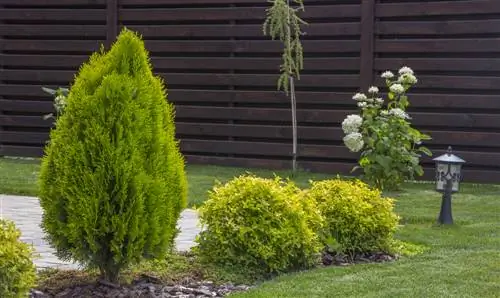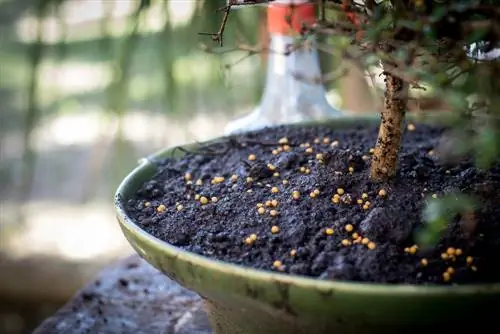- Author admin [email protected].
- Public 2023-12-16 16:46.
- Last modified 2025-01-23 11:21.
Only if the Kentia palm receives sufficient nutrients can it develop many green, he althy fronds. You therefore have to fertilize them regularly. How often you have to fertilize, which fertilizer is suitable and what else you need to consider.

How do you properly fertilize a Kentia palm?
To properly fertilize a Kentia palm, add special palm fertilizer or a flowering and green plant fertilizer rich in potassium and nitrogen to the irrigation water every four weeks during the growth phase from March to September. The palm tree is not fertilized in winter.
Fertilize Kentia palm properly
Kentia palms are only fertilized during the growth phase from March to September.
Add the fertilizer to the irrigation water at four-week intervals. Alternatively, you can of course also use fertilizer sticks, which, depending on the type of fertilizer, are administered in spring and again in summer.
Which fertilizer is suitable?
Special palm fertilizer (€13.00 on Amazon), which you can buy from garden shops, is suitable for fertilizing Kentia palms. Alternatively, you can also give a normal fertilizer for flowering and green plants. However, this should definitely be rich in potassium and nitrogen so that the Kentia palm is optimally supplied.
Don’t overdo fertilizing
The Kentia palm cannot tolerate too much fertilizer. Therefore, be economical and use a maximum of the dosage stated on the package. If you fertilize more often than once a month, you will need to reduce the dose more.
The Kentia palm is not fertilized in winter
In winter the Kentia palm takes a break. The palm tree must not be fertilized during this time. It will only receive fertilizer again from March / April - unless you have just repotted it.
Choose the right plant substrate
In order to optimally supply a Kentia palm with nutrients, the plant substrate plays an important role. Ready-made palm soil is almost always sufficient, as long as it is nice and loose and contains sand or gravel.
You can easily mix the substrate yourself. For this you need
- Compost-based soil
- Sand
- gravel
- Expanded clay or lava granules
By adding expanded clay or lava granules, you prevent the earth from collapsing and becoming too compacted over time. This means that the roots no longer get enough air and there is also a risk of waterlogging.
Tip
A Kentia palm only needs to be repotted every two to three years. To do this, replace the old substrate as completely as possible and place the palm tree in a deeper and slightly wider pot.






